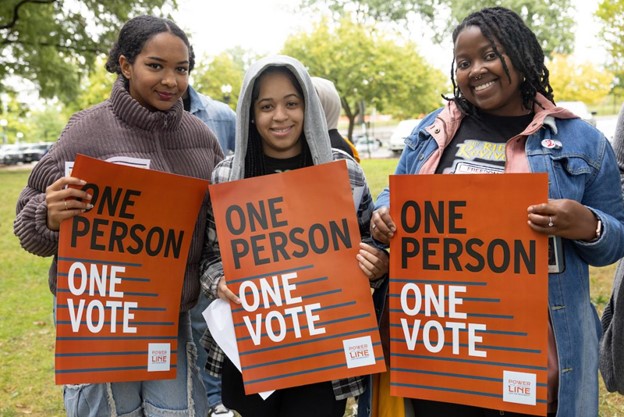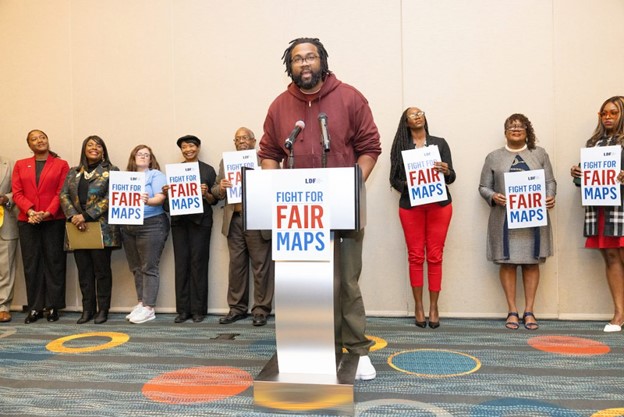Background:
The state legislature controls redistricting in Alabama. The legislature drew the maps with minimal change from maps drawn in previous decades. Despite Alabama’s large Black population, the congressional map was drawn to only have one district in which Black voters constituted a majority of the voting age population. In Allen v. Milligan, a case challenging Alabama’s congressional map under Section 2 of the Voting Rights Act (VRA), the Supreme Court ruled that Alabama had diluted Black voting power in its congressional voting map, reaffirming the power and importance of the VRA.1
The decision in Allen v. Milligan was an enormous win for Black Alabamians, voting
rights groups and groups fighting for fair redistricting across the country. However,
the Alabama legislature held a special session in July 2023 to redraw maps and failed to draw an additional majority-Black district.2 Civil rights groups are objecting to these maps in court as failing to comply with the Supreme Court ruling, and the matter has not been settled as of July 2023.
Community of Interest Story
Alabama voters, civil rights groups, and faith groups, including Evan Milligan, Alabama Values, Greater Birmingham Ministries, and Alabama State Conference of the NAACP, filed a federal lawsuit challenging the congressional and state legislative lines drawn by Alabama’s legislature. At the core of the challenge to Alabama’s congressional districts was the packing of the state’s Black population into a single district, while leaving stranded and dividing communities in Montgomery County where a second majority- Black congressional district could have been drawn. As Legal Defense Fund (LDF) Senior Counsel Deuel Ross described these communities, “the Black Belt is a historic and extremely poor community of substantial significance.”4 In June 2023, the U.S. Supreme Court agreed, issuing a resounding decision in Allen v. Milligan that affirmed the protections of Voting Rights Act against racial discrimination, overturning Alabama’s district lines in light of “Alabama’s extensive history of repugnant racial and voting-related discrimination.”
Grades:

Overall State Grade: F
Lack of racially polarized voting (RPV) analysis: Given past violations of the Voting Rights Act, many advocates petitioned repeatedly for the legislature to complete an RPV analysis to ensure that maps weren’t violating the VRA. The Legislature flatly rejected the request to complete a RPV analysis and the majority in the Legislature admitted no RPV analysis had been completed to determine whether packing Congressional District 7 was necessary to satisfy the VRA.
Inaccessible public hearings: While the Legislature held 28 public hearings across the state, none were accessible. Twenty-seven of the hearings were held during the working hours of 9 a.m. – 5 p.m., when the public was least able to attend. The only one that was held at 6 p.m. was at the Statehouse in Montgomery. Some advocates also said the Legislature used Microsoft Teams for their webinar platform, which was inaccessible to many people.
Rushed timeline: Draft maps weren’t released to the public by the Legislature until the day of their first meeting about maps. Legislators were only shown their districts, not the map as a whole – leaving many in the dark about the implications of the entire map.
 Local Grade: B
Local Grade: B
Advocates reported that it was often easier to hold local officials accountable on local maps, even if results did not end up being what communities wanted. In Prattville, a network of organizations and advocates was able to apply pressure in the city council redistricting process and successfully advocated for more time to analyze the process and proposed maps. Because local redistricting is hyperlocal, it requires careful observation in each county to ensure a fair process.
Lessons Learned:
- Alabama-specific messaging helps: Advocates spoke to the importance of messaging that tied redistricting to Alabama’s history, culture, and specific issues at play for Alabamians. Alabama Values was highlighted for their work on Alabama-specific messaging.
- Many trainings are needed for the mechanics of map making and interpreting census data: Interviewees highlighted the importance of multiple trainings on the nuts and bolts of map making and interpreting data, since this allowed communities to understand the process better and be better able to analyze maps.
- Research and reports specific to Alabama were helpful: Redistricting research, reports, and map trainings were instrumental in building a base for training people in the future and giving them tools to use as the base of their testimony.
- Hyper-local organizing is a real need: Advocates spoke repeatedly to the need to start local and then move statewide in future redistricting work. Starting local could help with civic engagement generally and get groups more invested in local stories and data before moving into big picture and state level work.
- More collaboration on the front-end: Coalition work can be difficult and there is natural division over different groups’ visions for ideal maps. Taking time for cooperation and tough conversations on the front end before presenting unity maps could help groups reach a consensus or understand divisions earlier.
- Define goals earlier in coalition: Similar to the previous point, organizations have different relationships and roles within the advocacy ecosystem. Defining goals earlier would allow groups to ensure they are bringing their best skills and that they can effectively engage in partnership with other groups.

